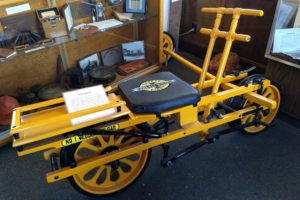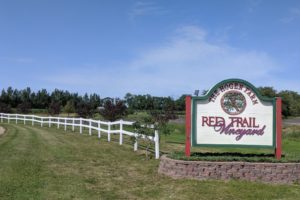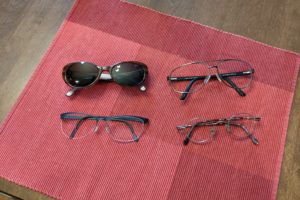Our 3rd museum in the Pembina area of NE North Dakota helped us look at its early history in more depth than the previous 2 museums in Cavalier that’s just 30 minutes away. At this 3rd museum we’re about 2 miles from the U.S.-Canadian border, which we can see from the observation deck in this picture. Come join us as we learn more.



- first European settlement
- first organized church
- first school
- first post office
- first border/customs house
- first homestead within present state borders
For most of the this area’s history, it has been remote and sparsely inhabited. Native people lived here on a seasonal basis when they could use such resources as the high bush cranberry, from which Pembina is thought to have been named. As transportation methods developed (ox carts, steamboats, automobiles and roads, and the railroad), the Pembina area became more accessible, populated, and well traveled.

The area’s earliest residents were nomadic people who traveled in and out of the area from all directions. Pembina’s recorded history is closely tied with Canada starting with early explorers and traders who came by river from Canada in the late 1700s to establish fur trade posts. The earliest permanent settlers also came from Canada or were involved with Canadian-American trade operations.
The Treaty of Ghent established the 49th parallel as the official boundary between the U.S. and Canada. No wonder the border between our 2 countries looks so straight. What was this treaty and when was it signed? Here’s the info from Wikipedia:
“The Treaty of Ghent was the peace treaty that ended the War of 1812 between the United States and Great Britain. It took effect in February 1815. Both sides signed it on December 24, 1814, in the city of Ghent, United Netherlands (now in Belgium).”

While a number of established Red River trails were used to link Winnipeg, Pembina, and St. Paul, 2 major routes were traveled in ND (see close up of the following map): The River Trail (in black) that hugged the west bank of the Red River, and the Ridge Trail (in red) that was on the east side of the plains. This second route was more important because it was drier, had fewer mosquitoes, and no enemies had places to hide along the trail.



Canvas-covered bows (front part of the cart) could serve as tents for the Metis when they had to stop overnight, and without the wheels, the cart could float across a river. Since carts were completely made of wood and rawhide, blacksmiths weren’t needed for repairs, which meant these repairs could be done while traveling. The wooden wheels produced a piercing squeak because of wood on wood, but no oil could be used because trail dust and mud would stick to the wheels. This squeak could be heard for miles and was as bad as a nail on a blackboard.
first peoples
At the end of the Ice Age, the weather was cool and moist. Glaciers covered northern parts of the continent, and Lake Agassiz covered the Red River Valley.
As the glaciers retreated and Lake Agassiz drained, plants and animals started growing. Trees such as aspen, birch, oak, and tamarack, as well as shrubs, grew along this wet valley area. Giant mammals such as mammoths and large bison populated the area.

Other resources for these early people were bison, deer, elk, beaver, muskrat, squirrel, and racoon that could be hunted or trapped. Early records also show that ducks provided them with food.

Archaic period from 5500 BC to 400 BC
At the beginning of this time, the climate became drier and warmer. People started living in small groups or bands so they could travel together to hunt animals and gather wild plants.


Throughout the ages, people have invented tools to make their lives easier. Such is this Atlatl Dart Foreshaft that was used for hunting smaller game animals on the prairie after the extinction of the many huge Ice Age mammals.



Here’s more information from Wikipedia:
“A spear-thrower, spear-throwing lever or atlatl is a tool that uses leverage to achieve greater velocity in dart or javelin-throwing, and includes a bearing surface which allows the user to store energy during the throw.”
The spear-thrower holds the shaft in one hand at the furthest end from the tip and throws the spear with his upper arm and wrist. The extra length of the throwing arm and the spear lets the thrower use more force with the dart so it can go a longer distance. Today’s molded plastic arms used for throwing tennis balls for dogs to fetch uses the same principle.

Wild game and plants were very lean so people had to supplement their diets by smashing and boiling animal bones to get its bone marrow grease. They cooked the bones in a waterproof container made of hides. Stones were heated in the fire and then dropped in the water to make it boil. The bone grease rose to the surface and was skinned off.

These rocks and boiled bone fragments are refuse from processing grease from bones. Fire-cracked rocks are stones fractured by exposure to fire; they are angular, crumbly, and sometimes pink in color.
Woodland period – 400 BC to AD 1000
During this transition time from the hunter-gathers to the farmers, people began making ceramic cooking and storage vessels.
I remember we learned about these different time periods and how people lived when we were in Mesa Verde National Park. If you’re interested in looking at this information, it’s in part 16 of the Four Corners posts during our Southwest Swing trip.

Plains period – AD 1000 to 1730
As Native peoples began to spread out in the prairies after the Ice Age was over, they were able to farm and started living in villages. They grew crops of corn, beans, squash, and sunflowers. Along the Missouri, James, and Sheyenne rivers, these people lived in earthlodge villages.



late prehistory – before the Europeans came
Before Euroamerican contact, various tribes traveled in and out of the Red River Valley, leading a nomadic lifestyle of hunting, fishing, and gathering plants.

They made their tools from such natural materials as stone, shell, wood, and bone. In the 1700s, European goods arrived with the fur traders, including metal, cloth, glass, and steel.


fur trade
The fur trade era was a time of transition and change in the Red River Valley and the rest of North America. Native American and European cultures met and mingled. Each group had something to give and something to gain from this meeting. Native cultures traded furs and pelts, and Europeans traded manufactured goods, alcohol, and tobacco.

These 2 companies retreated north after the 49th parallel was established as the border between the U.S. and Canada in 1815.
By the 1840s, Red River ox carts were the principal means of transporting furs south and goods north. Eventually the carts were used along with steamboats and railroads. By the beginning of the 20th century, the fur trade era had ended. These animals had been nearly hunted to extinction, and settles were moving into the region.


But in business, competitors can become partners. In 1821, they merged under the name Hudson’s Bay Company; it’s still in existence today.
The only other long-term contender for the Red River trade was the American Fur Company owned by John Jacob Astor. Free traders, like the Metis, struggled to break the monopoly held by Hudson’s Bay Company, but had little success.





right: a mid-17th century furrier’s shop in Paris
early trade from 1790 – 1830
European fur traders first reached this area in the late 1700s. The first written records for local fur trading came from the journals of Charles Chaboillez who established a North West Company post called Fort Pambian at the mouth of the Pembina River during the 1797-98 season.




The long canoe trip was dangerous because of rapids and rocks that could punch holes in the fragile vessels.


When occasional passengers came on a canoe trip, they were often carried on a voyageurs’ backs during the portages so the expedition wasn’t slowed down. Amazing.


Most of the animals trapped for their fur we know about. But the museum had a couple of animals that were new to us.


goods traded for furs
Such manufactured goods as glass beads, mirrors, guns, fire steels, blankets, woven cloth, metal utensils, and metal decorations appealed to the Native Americans. They were thought to be exotic to the native cultures.



flintlock rifle
So many steps to make this rifle work.

The lock mechanism is on the top of the gun. To load the gun, a measure of gunpowder is poured into the barrel. Then a cloth patch is inserted into the gun barrel to provide a tight fit for the musket ball, which is inserted next.
To fire, powder is poured into the pan on the side of the gun. The hammer, attached to the gunflint, is pulled back (or cocked). When the trigger is pulled, the hammer snaps down, and the frizzen (hammer) moves forward.
The attached gunflint strikes the front of the frizzen, dropping a shower of sparks into the powder pan. The powder then ignites and sends a flame into the barrel. The gunpowder ignites in the barrel, and the resulting explosion causes the musket ball to shoot out. Phew.


early colony
After reading the memoirs of Alexander Henry (remember him from parts 9 and 10), Thomas Douglas, Fifth Earl of Selkirk, had a dream of colonizing the New World. As a shareholder in the Hudson’s Bay Company, he purchased enough additional stock to acquire a controlling interest.


The Selkirk colonists landed at the fork of the Assiniboine and Red rivers (near Winnipeg) in late 1812.


later fur trade – 1830 to 1880
In 1844, entrepreneur Norman Kittson (we’ve heard of him before in parts 9 and 12) built an American Fur Trade Company post at Pembina and began serious competition against the powerful Hudson’s Bay Company monopoly.


Soon business intermixed with politics, and Kittson served in the Minnesota territorial legislature and became the first U.S. postmaster in present-day North Dakota. Kittson and James Hill became business partners and established the Red River Transportation Company that monopolized steamboat service on the river in the 1860s and 1870s. Busy man!
beaver to bison
Eventually the focus of trade turned from beaver to bison as people moved away from the rivers to the prairie. The area between Pembina and Winnipeg was filled by a large, mobile population of Metis people who were descendants of fur traders and Native Americans.
Twice each year they met at St. Joseph (Walhalla), west of Pembina, and traveled as far west as necessary to find large bison herds. The first hunt was for selling furs, and the second hunt was for themselves.


Bison trade lasted until the 1880s when the herds were hunted to the point of near extinction.
Metis culture
Previously we’ve referred to the Metis in parts 2, 9, 10, and 14.

A new ethnic group was born in the Red River Valley as a result of the fur trade. Marriages between European men in the fur trade and native women were very common since European women weren’t in the area. Also, these native women were hardy and knew how to live on the land. Their children and descendants became known as the Metis, meaning mixed in French.

They spoke their own language, a combination of French and Cree. They adopted Catholicism as their religion, dressed in a colorful combination of native and European clothing (we’ll see some soon in this post), and based their economy on the fur trade from their 2 bison hunts a year.

Native and Metis women tanned perishable hides and made pemmican. In 1821, around 500 Metis were living around Pembina; the population climbed in 1843 to 2600, and in 1870 it exceeded 12,000.







Metis clothing





early fur traders





One of Pembina’s most colorful figures, Joe Rolette Jr. was known as Jolly Joe. His father was one of Pembina’s earliest settlers, and several family members were prominent in the fur trade. Jolly Joe was also involved with early commercial Red River cart trains to St. Paul. He took over Kittson’s trading post at Pembina in 1852 and was said to have ruled the village “like a feudal lord.”

Joe Rolette, Jr. is well-known in Minnesota state history, During one term in the territorial legislature, he single-handedly prevented passage of a bill that would have moved the territorial capitol from St. Paul to St. Peter (south of Minneapolis/St. Paul).

According to a the St. Paul Pioneer quote in January 1852, “Messrs. Kittson, Rolette, and Gingras arrived . . . 16 days from home, stopping 2 days at Red Lake by the way. Each had his cariole [dogsled] drawn by 3 fine dogs, harnessed tastily, with jingling bells, and driven tandem fashion, at 2:40 at least, when put to their speed. They usually traveled from 30 to 40 miles per day, and averaged about 35 miles. They fed the dogs but once a day, on the trip, and that at night, a pound of pemmican each. On this, they draw a man and baggage as fast as a good horse would travel, and, on long journeys, they tire horses out.”



Twice Metis leader Louis Riel led resistance movements against the Canadian government over Metis land rights and political represent. Both times he set up a provisional government. While some of their political demands were met, many Metis fled into ND and western Canada. Eventually Riel was found guilty of treason and hanged.


As the U.S. made territories and states, the military started making its presence known. The next post starts with the military presence and takes us up to modern day in Pembina.




